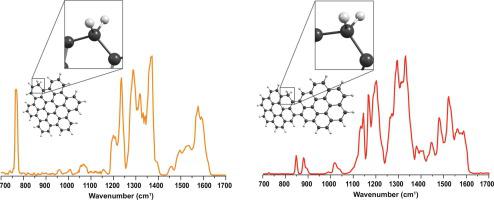Journal of Molecular Spectroscopy ( IF 1.4 ) Pub Date : 2021-04-26 , DOI: 10.1016/j.jms.2021.111474 Julianna Palotás , Jonathan Martens , Giel Berden , Jos Oomens

|
The mid-infrared emission spectra of a large variety of astronomical objects are dominated by the aromatic infrared bands (AIBs), which are now widely accepted to originate from gaseous polycyclic aromatic hydrocarbons (PAHs). It is believed that the astrophysically most relevant molecules are at least 40–50 carbon atoms in size. Still, the large majority of laboratory experiments have been performed on smaller PAHs, mainly for reasons of experimental limitations and availability. Here, we show that combination of atmospheric pressure chemical ionization (APCI) with a direct insertion probe (DIP) inlet gives efficient access to larger, ionic PAHs for action spectroscopy studies. We present the gaseous IR spectra of two astrophysically relevant large PAHs, hexa-peri-hexabenzocoronene () and dicoronylene () in their protonated form. Compared to their radical cation analogs, the protonated species have a lower dissociation threshold as they can expel a neutral hydrogen radical leaving behind the resonance-stabilized radical cation; provided that the mass spectrometer can resolve precursor and product ions at one amu difference, this generates good quality spectra under multiple-photon dissociation conditions. Quantum-chemical computations at the density functional level are used to support experiments. Despite the apparent similarity of different protonation isomers, their IR spectra are predicted to be remarkably distinct. This facilitates a straightforward identification of the isomers formed experimentally. For both species studied, protonation occurs on the peripheral CH moiety in the ’bay region’ of the molecules. We compare the spectra of the protonated species with those of their radical cation analogs reported previously and briefly discuss the astrophysical relevance.
中文翻译:

质子化的六-peri-hexabenzocoronene和dicoronylene的实验室红外光谱
各种天文物体的中红外发射光谱受芳香族红外波段(AIB)的支配,现在已被广泛接受起源于气态多环芳香烃(PAHs)。人们认为,与天体物理学最相关的分子的大小至少为40-50个碳原子。尽管如此,大多数实验室实验还是在较小的PAH上进行的,主要是出于实验局限性和可用性的原因。在这里,我们显示了大气压化学电离(APCI)与直接插入探针(DIP)入口的结合,可以有效地利用较大的离子型PAH进行作用光谱研究。我们介绍了两个与天文学相关的大型PAHs的六边-六-六苯并co苯的气相红外光谱()和二亚戊二烯基()的质子化形式。与它们的自由基阳离子类似物相比,质子化的物种具有较低的离解阈值,因为它们可以排出中性的氢自由基,而留下共振稳定的自由基阳离子。只要质谱仪能够以1个amu的差异分辨前体离子和产物离子,就可以在多光子解离条件下生成高质量的质谱图。密度函数级的量子化学计算可用于支持实验。尽管不同的质子化异构体具有明显的相似性,但预计它们的IR光谱会明显不同。这促进了对通过实验形成的异构体的直接鉴定。对于所研究的两个物种,质子化均发生在分子“海湾区域”的外围CH部分。

























 京公网安备 11010802027423号
京公网安备 11010802027423号